This month Arctic sea ice reached its second lowest extent on record, and modeling shows it will completely melt in summer by 2035. But where many see a disaster, some global powers discern an opportunity to secure geopolitical and commercial interests – and military ones.
The UK, the United States and Canada have been among the countries ramping up their Arctic military exercises, and for the past five years, photographer and film-maker Louie Palu has been taking pictures of soldiers confronting an environment as hostile and deadly as any enemy force. He has photographed a parachute drop into mountainous terrain in Alaska, “through-the-ice” training in a lake in the Northwest Territories, a submarine coming up from under the ice in the Beaufort Sea and igloo-building and radar operations in Nunavut. He saw soldiers suffer frostbite and, during exercises in Finland, even be killed in a vehicle accident, he said.
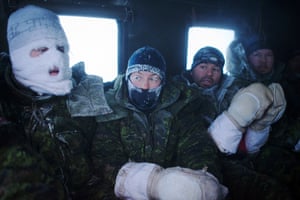
“There’s an element of failure or disaster about to happen in every photograph, or absurdity,” Palu said. “I broke my ribs twice. I scratched my cornea with ice. The only time I’ve ever seen soldiers more afraid than going out in -60 [degrees Celsius] is Afghanistan when you walk through IEDs.”
The Arctic has always been something of a blank slate, a place so barren and vast it invited humans to invest it with their greatest dreams and fears. As the famous chronicler of the far north Barry Lopez wrote, “people’s desires and aspirations were as much a part of the land as the wind, solitary animals, and the bright fields of stone and tundra”.

For 16th-century explorers, it was a prospective trade route to the Orient. For 17th-century whalers, it was an El Dorado of bowhead blubber and walrus tusks. For cold war defence planners, it was the shortest flight path for a ballistic missile strike.
Following the Soviet collapse, the Arctic was mostly forgotten until 2007, when a submersible planted a titanium Russian flag at the north pole to highlight Moscow’s claim to economic rights over a wide swath of the seafloor there, provoking angry reactions from Washington and Ottawa. Denmark and Canada have since filed their own overlapping seafloor claims.
“Imagination and the unknown are the two themes that everything bottlenecks to,” Palu said. “It’s the unknown future of this planet because of climate change and the opening up of a part of the world that no one cared about before.”
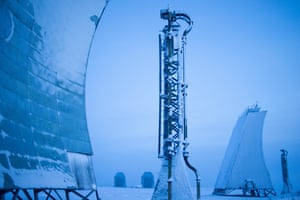
But the warming of the Arctic has galvanised resource extraction more than environmental concerns. Shipping on the Northern Sea Route along Russia’s Arctic coast, which Vladimir Putin hopes will become an alternative to the Suez Canal, is expected to reach 32m tonnes this year, 80% of it oil and gas from huge fields on the Yamal peninsula. The state oil giant Rosneft is drilling the world’s northernmost oilwell offshore and developing what it says will be the world’s biggest oil project onshore.
On the American side, the Trump administration has pledged drilling lease sales in the Arctic national wildlife reserve by the end of the year. And it reversed an Obama-era ruling that would have nixed the proposed Pebble Mine, thus setting the stage for a gold and copper project that environmentalists say will harm the world’s largest sockeye salmon fishery.
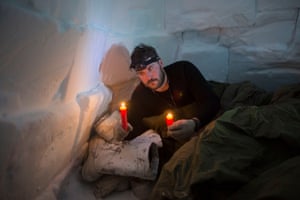
As economic interests in the north have grown, so have military patrols to test or defend territorial boundaries. Following the 2019 declaration by the US secretary of state, Mike Pompeo, that it was “America’s moment to stand up as an Arctic nation”, the US deployed destroyers off Russia’s northern coast in May – and for the first time since the 1980s. In July, the air force released its inaugural Arctic strategy. Last month Senator Dan Sullivan said the US will deploy 100 F-22 and F-35 fifth-generation fighter jets to Alaska, where US aircraft have intercepted Russian warplanes at least a dozen times this year.
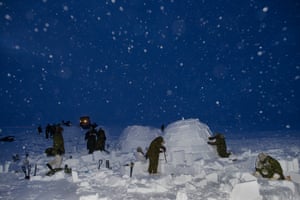
US and Russian submarines are reportedly hiding under the ice in numbers not seen since the cold war, and last week a vessel operated by Russia’s main directorate of deep-sea research, which is developing a nuclear-powered underwater drone and is believed to be targeting Arctic fiberoptic cables, returned from its maiden voyage through Arctic seas.
No one seriously believes that Russia would deploy its recently developed combat snowmobiles to Resolute Bay, or that the US would drop paratroopers on the other side of the Bering Strait. But more assets in the Arctic means a greater risk of accidental collisions or shootouts.
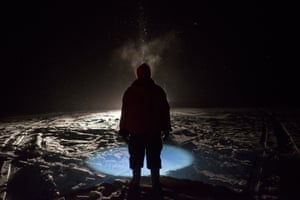
“The likelihood of hot conflict involving land-based troops is very low,” said Lillian Hussong, a research associate at the Washington-based Arctic Institute. “What I am concerned about is competition, with that comes the likelihood of miscalculation. A lot of risk in the Arctic has to do with miscalculation and not understanding adversaries’ intentions.”
The involvement of “near-Arctic state” China in the region further complicates the picture. It just sent its second icebreaker, Snow Dragon 2, on a maiden voyage to gather sediment cores in the Arctic Ocean, and Beijing-based Cosco is the only one of the five major container shipping companies sending vessels through the Northern Sea Route each year as part of the “Ice Silk Road” initiative with Russia. Some in the west suspect that these scientific and commercial pursuits could lead to espionage or military activity.

“I’ve done 117 interviews with American military officials and diplomatic officials stationed in Arctic areas, and the Chinese are always brought up,” Hussong said. “And when I ask about threats to us in the Arctic, sometimes Russia isn’t brought up at all, but after climate change China comes next.”
The burgeoning commercial and military rivalries in the far north are in fact a distraction from the real problem, which is the devastating effects of climate change. These include a deadly anthrax outbreak in northern Russia in 2016, rain-on-snow events leading to the starvation of thousands of reindeer, and a permafrost thaw that was blamed for the largest ever Arctic oil spill this summer. Writing about the Arctic buildup in the latest issue of Foreign Affairs, an American and British academic argued that the United States is heading “toward an unnecessary confrontation in a region where the real enemy isn’t cold war ghosts but looming environmental disaster”.

In this light, the far-ranging military exercises Palu photographed smack of hubris rather than mastery.
“What are they waiting for? They’re waiting for they don’t know,” Palu said. “So it’s an imagined threat, but the irony is that climate change is the real threat. Climate change will destroy everything up there, not another army.”
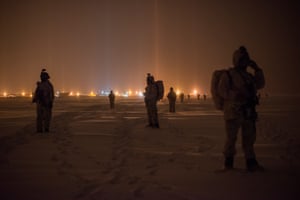
This project was supported by the John Simon Guggenheim Memorial Foundation and The Pulitzer Center
